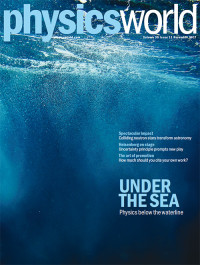 By Matin Durrani
By Matin Durrani
Physicists love a challenge. Some have experiments up in space, while others work deep underground or at the tops of mountains. But just imagine how hard it must be for the those physicists who do experiments at sea.
The November 2017 issue of Physics World, which is now out in print and digital format, examines some of the challenges for physicists working below the waterline.
Jon Willis describes his experience on the exploration ship Nautilus in the Pacific Ocean, looking for mineral-rich “black smokers” that support life in conditions mimicking those on Jupiter’s icy moon Europa. Helen Czerski reveals why her studies of bubbles could help those who model climate change, while Antoine Kouchner and Véronique Van Elewyck explain why and how researchers are using the ocean as a giant neutrino detector.
Remember that if you’re a member of the Institute of Physics, you can read the whole of Physics World magazine every month via our digital apps for iOS, Android and Web browsers.
For the record, here’s a run-down of what else is in the issue.
• Astronomers see neutron stars collide – LIGO and Virgo scientists see spectacular collision
• LIGO pioneers bag Nobel prize – Rainer Weiss, Barry Barish and Kip Thorne share the 2017 Nobel Prize for Physics for their work on gravitational waves, as Hamish Johnston reports
• Opening up the physics closet – Michael Falk says that minorities in physics are regularly subjected to silencing, erasure and ostracism from colleagues – and that we can do better
• What philosophers do – Robert P Crease explains what philosophers of physics get up to
• 20,000 pings under the sea – In the deep, dark depths of the ocean, where chimneys spout hot black clouds of particles, there is life. Astronomer Jon Willis sets out on a voyage to understand these harsh environments and search for clues about whether life could also survive on watery moons in our solar system
• Looking at the sky from the depths – Building an experiment at the bottom of the sea to detect neutrinos from outer space might seem an odd thing to do, but researchers have been perfecting the unusual pairing for half a century. Antoine Kouchner and Véronique Van Elewyck explain why and how researchers are using the ocean as a giant neutrino detector
• Behold the bubbly ocean – A bubble in the ocean may seem insignificant, but consider all the bubbles in all the oceans and you find a powerful influence on the planet. Physicist and oceanographer Helen Czerski talks about her expeditions into stormy seas to learn more about these tiny pockets of gas
• Animal magic – Mark Denny reviews Furry Logic: the Physics of Animal Life by Matin Durrani and Liz Kalaugher
• Superhero science: from fiction to fact – Michael Follow reviews The Secret Science of Superheroes edited by Mark Lorch and Andy Miah
• Uncertainty and punk physics – Tushna Commissariat talks to Tony and Olivier-Award-winning playwright Simon Stephens about his play Heisenberg: the Uncertainty Principle, and how he was inspired by quantum mechanics
• How much self-promotion is enough? – Promoting your career is the name of the game for most researchers, but is excessively citing your own papers a good or bad thing? Dalmeet Singh Chawla investigates
• Once a physicist: Angus Jackson – Meet the theatre director of the Royal Shakespeare Company’s current Rome Season
• Do you really want to be a fly on the wall? – David Pye on what flies see, sense and hear
Trackback: จำหน่ายเครื่องมือมากมายหลากหลาย สว่านไฟฟ้า สว่านไฟฟ้าไร้สาย เครื่องขัดกระดาษทราย เครื่อ